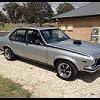Filling the block helps with ring seal - stiffens up the bores, less flexing = better ring seal = more HP, less blowby & longer ring life.
Also damps harmonics that can lead to stress cracks.
I'd fill it.
I fill just about everything serious I build, pretty much no downsides for a short fill. You can feel the extra rigidity in the bores just honing the block, the bore do not 'push' with the hone - you can go closer to finished size before letting it settle to recheck where you're at, after settling they do not shrink as much as ungrouted blocks & you do not get as much variation from deck & crankcase ends of the bore compared to the middle - without a fill the more rigid top & bottom of the bores hold their size better while honing, but the middle moves around with the pressure/heat of honing & you have to stop & let it settle to see where you're really at.
If the bores move that much (can be a solid .0005", sometimes more) from just the pressure of hone stones imagine how much they move under combustion pressure.
I'll usually fill to about 2" below the deck face on most engines, but a holden 6 you can't fill that high due to the water pump, you can fill above the water pump hole tho - put a plate over it & fill about 1" above the bottom of the pump hole. Once the grout has cured you can get in there with a die grinder & grind out the grout that'll interfere with the water pump.
Loss of coolant capacity is no biggie, never had a hot runner even with some pretty tall fills - all the cooling in the block happens within 1.5" of the deck face, so long as you make up the coolant volume with larger end tanks on the radiator you're golden.
You also should run an oil cooler - the oil will no longer be cooled by the water jacket & will run hot without a cooler.

















